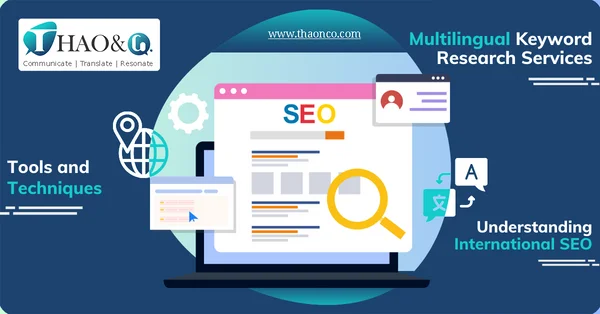International SEO keyword research is not just about those dry formulas and dusty well-rehearsed tips and tricks. Think of it as a vibrant adventure into the uncharted water of global search behavior.
Sure, strategic frameworks and technical factors have their own roles. However, they are mere stepping stones; it’s the spirit of exploration done right that truly propels us forward.
Mastering the art of international keyword research for SEO-friendly content is a must for any business aiming for global success. Consider this guide your ultimate handbook to multilingual keyword research. By arming you with the most essential terms and vital insights from our work experience, Thao & Co. will set you on the right track to craft internationally optimized content that charms visitors from far and wide.
International SEO keyword research is the art and science of uncovering the keywords that people in different countries are using to search for products and services like yours. It’s about understanding their language, their needs, and their online behavior.
But why is it so important?
Because without the right keywords, your website is like a gourmet restaurant lost in a culinary wasteland. People simply won’t be able to find you. International SEO keyword research prevent that worst case scenario by enabling you to:
Don’t underestimate the power of international SEO keyword research. It’s your golden key to unlock global markets and build a brand that truly resonates with audiences around the world.

The very first step when performing international SEO keyword research is analyzing your ideal geographic targets so that your content localization strategies resonate with each region’s local search behavior and trends.
First things first, where do you intend to expand your business? Global expansion has a nice ring to it, but going international requires carefully evaluating potential target countries and narrowing focus. Here are some factors to take into consideration:
You can start with a straightforward PEST analysis to compare countries across Political, Economic, Social, Technological, and other factors. Google’s Market Finder can be helpful when benchmarking your target countries across key dimensions such as population size, GDP, e-commerce adoption, website and mobile usage, and ease of doing business rankings.
By identifying focused geographies for your initial rollout, you can study your target markets before expanding further. Most businesses typically aim at English speaking countries or emerging markets with high growth and preexisting brand recognition as early phase targets.
Every region has their own differences in language conventions, terminology, cultural references, and more – all of which shape keyword usage and search behavior. If you make assumptions based on your home country’s understanding, you will most likely end up with ineffective localization. After all, something as simple as “biscuits” are understood differently in the US and the UK.
The key is to understand the linguistic intricacies, including commonly used slang, dialects, and recent trends in each country. At Thao & Co., this task is trusted to native linguists to ensure the keyword glossaries resonate as intended. With a team of translators, editors, and consultants who are locals and culture connoisseurs, our keyword research and cultural adaptation are done right down to the use of emojis.
And yes, we are not exaggerating. Even emoji usage varies geographically. Americans associate excessive use of emojis with multi-level marketing. In Vietnam, a friendly smiling emoji at the end of a message can be understood as passive aggressiveness, while a penguin icon signifies that the message is satire/sarcasm. Who would have thought? Such nuances can significantly impact your international SEO success.

It goes without saying that search behaviors, preferred content types, user expectations, and user journeys differ across target markets. The search experience in every region is influenced by economic factors, technological maturity, and local business practices. Some regions prefer visual content over texts, while others, Japan for example, are more comfortable with dense texts and few images on a webpage.
Terms used to describe the same concepts may be searched differently across markets. This is evident in Koreans’ search behaviors. For the topic Black Friday promotion, Koreans prefer the search query “블프 세일” (“BF promotion”, an abbreviation) over the full term “블랙프라이데이 세일” (“Black Friday promotion”). To optimize for a location, meticulous research is essential.
On top of that, user intent refers to the goal or purpose behind a specific search query. It’s all about what content searchers actually find useful. Their intent and usage of branded vs. generic searches may reflect different stages in their purchase process as well.
For example, depending on the seasons or time of the year, the search intent for a product category term such as “shirts” could reflect demand for:
The search may also indicate:
As a result, the user intent and search context provides useful directions for content based on the same “shirts” terms across time and geographies. Actively researching and reverse engineering these subtle nuances is an important part of international SEO keyword research.
Thao & Co.’s SEO specialists understand that simply translating keywords to the local languages can only provide surface level localization. For each and every localization project, we go the extra mile during our keyword research phase to uncover geo-specific searcher intent. This effort allows us to identify localized keywords that we then craft content that precisely match in relevance, depth, and context per market.
In particular, after analyzing local search behavior, we feed contextual insights into our keyword research, uncovering the unique queries used across search stages, and developing groups of related keywords that reflect the user journeys. This means not only translating keywords but also matching them to geo-specific searcher intent. This deep analysis guides our locally-optimized SEO content that resonates with each target market.
By now, you already know that direct translation of keywords doesn’t work. But what does? Succeeding at international SEO requires a combination of expertise in leveraging keyword research tools that provide geo-specific data, then artfully applying the results into your content to make it relevant to your target audience.

Keyword research tools are getting more and more advanced. Top choices such as Ahref, SEMrush, or your trusty Google Keyword Planner offer a wide range of capabilities:
When conducting international SEO keyword research, it’s important to go beyond simply looking up the most popular terms. Most SEO newbies have the urge to grab the most searched terms they can find and shove them into their content. But that is actually the opposite of what you should do.
High volume equals high competition. Such popular keywords may seem enticing to target. However, the level of competition from major brands makes it near impossible to rank well for these terms. So what’s our play? Instead of chasing ultra competitive keywords, go for less competitive long tail variations that still have a decent search volume for your niche.
For example, instead of targeting a generic, broad term like “shoes,” you will have better results with more specific, targeted phrases such as “office shoes for ladies.” By doing so, you can match your content to more specific user intent, which ultimately leads to better conversions. After all, someone who really wants to buy a pair of new shoes will search for the exact type of shoes they need, not just “shoes” in general.
Looking to expand your online presence across borders? You’re in the right place. Thao & Co’s Multilingual Keyword Research service is here to help. Our team of native linguists and international SEO experts offer a comprehensive suite of SEO services to tailor your brand content to resonate in the most nuanced overseas markets.

As your trusted SEO content partner, Thao & Co. helps you develop international content that is on-brand, on-message, and most importantly, yields measurable ROI. International search visibility, traffic, engagement, and conversion – We maximize what’s possible globally.
Head over to our Get a Quote page and leave your project information today for a free consultation.